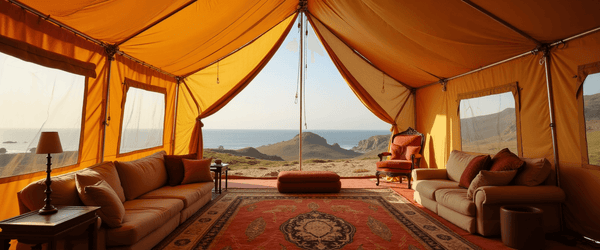What Is an A-Frame Tent? A Complete Buyer’s Guide for 2025
Jun 05, 2025
Camping gear trends continuously evolve, but some classics always find their way back into the spotlight. A-frame tents, with their simple yet functional design, are making a comeback among outdoor enthusiasts in 2025. But what is an A-frame tent, and why is it capturing the attention of modern campers again?
If you’ve spotted this triangular-shaped tent on your latest camping trip or seen it highlighted in a gear catalog, you might be wondering what makes it stand out. This guide will walk you through everything you need to know—from its structure and benefits to comparisons with dome tents and why it’s still relevant in the world of outdoor adventures.
What Is an A-Frame Tent?
An A-frame tent, often called a ridge tent, is one of the oldest tent structures, characterized by its triangular shape and sloped roof supported by a central ridgeline. Its structure mimics the capital letter "A," with its two slanting sides meeting at the top ridge and forming a peak.
Traditionally, A-frame tents were a popular choice for military and scouting activities due to their low weight and ease of setup. These tents were originally made from heavy-duty canvas and wooden poles. Over the years, they’ve evolved, now often constructed with lightweight synthetic materials and collapsible aluminum or fiberglass poles, making them more adaptable to various outdoor conditions.
The design’s simplicity emphasizes functionality while offering the nostalgia of classic camping tent styles.
Benefits of A-Frame Tents
Why should you consider an A-frame tent for your camping adventures? There are several practical advantages that make it an appealing option, especially in 2025 as minimalist outdoor gear becomes more popular.
Easy and Quick to Set Up
The simple design ensures that A-frame tents are incredibly straightforward to pitch. With just a few poles and a ridgeline, even beginners can set one up in minutes, making it ideal for impromptu camping trips.
Excellent Wind Resistance
Thanks to their sloped roof design, A-frame tents can handle windy conditions better than structures with flat or expansive walls. The streamlined shape minimizes wind resistance, reducing the risk of your tent collapsing in gusty weather.
Lightweight and Packable
A-frame tents, especially modern versions, are lightweight and compact, making them an ideal choice for solo campers or backpackers who prioritize mobility and ease of transport.
Compact Footprint
Unlike dome or cabin tents, A-frame tents require less surface area for setup, which is advantageous when camping in tight or uneven terrain.
Versatile Design
With variations such as canvas A-frame tents for durability and lightweight styles for portability, there’s an option to suit every camper’s specific needs.
A-Frame Tent vs Dome Tent Which Should You Choose
When choosing between an A-frame tent and a dome tent, understanding the key differences can help you make an informed decision based on your camping style and priorities.
|
Feature |
A-Frame Tent |
Dome Tent |
|---|---|---|
|
Shape |
Triangular with a ridgeline |
Rounded with curved poles forming a dome |
|
Space |
Limited headroom, narrow interior |
More spacious and suitable for larger groups |
|
Weight |
Lightweight, easy to carry |
Heavier due to additional poles and features |
|
Stability |
Excellent wind resistance thanks to sloped sides |
Stable on flat terrain but may struggle in wind |
|
Setup |
Simple and quick to pitch |
Slightly more complex setup |
When to Choose an A-Frame Tent
- You’re solo camping or need a lightweight option.
- You’re heading to a windy location.
- You prioritize functionality and simplicity.
When to Choose a Dome Tent
- You need more interior space for a group.
- You’re camping in mild, flat terrain.
- You prefer a more modern tent design.
Common Types of A-Frame Tents
Not all A-frame tents are created equal. Depending on your camping style, you can choose from these popular types in 2025:
1. Canvas A-Frame Tents
- Durability: Heavy-duty construction makes them ideal for long-term use.
- Weather Resistance: With proper treatment, they’re waterproof and offer excellent insulation during colder weather.
- Use Case: Perfect for glamping setups or retro-inspired camping trips.

2. Lightweight Backpacking A-Frame Tents
- Weight: Designed for portability, they usually weigh less than 3 pounds.
- Materials: Constructed from modern lightweight fabrics for easy packing and carrying.
- Use Case: Ideal for solo campers or hiking expeditions.

3. DIY A-Frame Tents
- Customization: Great for those who enjoy building their own shelters using tarps and ropes.
- Versatility: Perfect for ultralight enthusiasts and bushcraft adventurers.

Why A-Frame Tents Are Still Relevant in 2025
Outdoor gear trends often lean towards innovation, but A-frame tents prove that some designs are simply timeless. Here are a few reasons why they continue to capture the attention of campers in 2025.
Back to Basics
The minimalist camping movement is on the rise, and A-frame tents align with this trend. Their no-frills design focuses on getting the job done without unnecessary complexity.
Favorable for Ultralight and Bushcraft Communities
With their lightweight structure and adaptability, A-frame tents are a favorite among ultralight hikers and bushcraft enthusiasts who enjoy tackling the wilderness with only the essentials.
Sustainable and Repairable
Canvas A-frame tents, in particular, are environmentally friendly options. They are biodegradable, easier to repair, and last longer, reducing the need for frequent replacements.
Retro and Glamping Appeal
The nostalgic aesthetic of A-frame tents makes them a popular choice for glamping setups and Instagram-worthy camping adventures.
FAQ's
1. What makes an A-frame tent different from other tents?
A-frame tents have a distinct triangular shape with a sloped roof supported by a central ridgeline. This design offers excellent wind resistance and ease of setup, unlike dome or cabin tents.
2. Are A-frame tents suitable for winter camping?
Yes, especially canvas A-frame tents, which provide insulation and withstand snowy conditions. However, lightweight A-frame tents may require additional measures to ensure warmth.
3. Is a canvas A-frame tent waterproof?
Canvas A-frame tents are usually treated to be water-resistant, but adding a rainfly or reproofing the canvas can improve their waterproofing capabilities.
4. Are A-frame tents good for solo travelers?
Absolutely! Lightweight A-frame tents are compact, easy to carry, and quick to set up, making them a great option for solo campers.
Why You Should Consider an A-Frame Tent
For campers in 2025, A-frame tents represent the perfect blend of simplicity, functionality, and nostalgia. Whether you’re a solo backpacker seeking a lightweight shelter or a glamper chasing retro vibes, there’s an A-frame tent for you.
Explore our curated collection of A-frame tents to find the perfect match for your adventures or check out more tips for setting up the ideal campsite. Your next great outdoor experience starts here.


